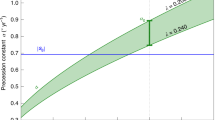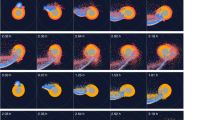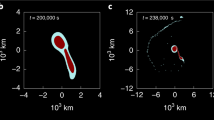Abstract
The planet Mercury rotates three times about its spin axis for every two orbits about the Sun1,2, in a 3/2 spin–orbit resonance. This unique state has been explained by an initial rapid prograde rotation, which was then decelerated by tidal torques to the present resonance3,4,5,6. When friction at the core–mantle boundary is accounted for, capture into the 3/2 resonance occurs with a probability of only 26%, whereas the most likely outcome is capture into one of the higher-order resonances7. Here we use a numerical model of Mercury’s rotational evolution to investigate the consequences of an initial retrograde rotation of Mercury. We find that in this case, the planet would be captured into synchronous rotation, with one hemisphere always facing the Sun, with a probability of 68%. Strong lateral variations in the impact cratering rate would have existed, consistent with the observed distribution of large impact basins. Escape from this highly stable resonance can be initiated by the momentum imparted by large, basin-forming impact events8,9,10, and subsequent capture into the 3/2 resonance is likely. During synchronous rotation, substantial quantities of volatile deposits would have accumulated on the hemisphere facing away from the Sun, potentially explaining the existence of sublimation hollows on Mercury’s surface11.
This is a preview of subscription content, access via your institution
Access options
Subscribe to this journal
Receive 12 print issues and online access
$259.00 per year
only $21.58 per issue
Buy this article
- Purchase on Springer Link
- Instant access to full article PDF
Prices may be subject to local taxes which are calculated during checkout



Similar content being viewed by others
References
Pettengill, G. H. & Dyce, R. B. A radar determination of the rotation of the planet Mercury. Nature 206, 1240 (1965).
Colombo, G. Rotational period of the planet Mercury. Nature 208, 575 (1965).
Colombo, G. & Shapiro, I. The rotation of the planet Mercury. Astrophys. J. 145, 296–307 (1966).
Goldreich, P. & Peale, S. Spin–orbit coupling in the Solar System. Astron. J. 71, 425–438 (1966).
Counselman, C. C. III & Shapiro, I. I. Symposia Mathematica, Istituto Nazionale di Alta Matematica Vol. III, 121–169 (Academic, 1970).
Correia, A. C. M. & Laskar, J. Mercury’s capture into the 3/2 spin–orbit resonance as a result of its chaotic dynamics. Nature 429, 848–850 (2004).
Correia, A. C. M. & Laskar, J. Mercury’s capture into the 3/2 spin–orbit resonance including the effect of core–mantle friction. Icarus 201, 1–11 (2009).
Melosh, H. J. Large impact craters and the Moon’s orientation. Earth Planet. Sci. Lett. 26, 353–360 (1975).
Lissauer, J. J. Can cometary bombardment disrupt synchronous rotation of planetary satellites? J. Geophys. Res. 90, 11289–11293 (1985).
Wieczorek, M. A. & Le Feuvre, M. Did a large impact reorient the Moon? Icarus 200, 358–366 (2009).
Blewett, D. T. et al. Hollows on Mercury: MESSENGER evidence for geologically recent volatile-related activity. Science 333, 1856–1859 (2011).
Margot, J. L., Peale, S. J., Jurgens, R. F., Slade, M. A. & Holin, I. V. Large longitude libration of Mercury reveals a molten core. Science 316, 710–714 (2007).
Peale, S. J. & Boss, A. P. A spin–orbit constraint on the viscosity of a Mercurian liquid core. J. Geophys. Res. 82, 743–749 (1977).
Laskar, J. Chaotic diffusion in the Solar System. Icarus 196, 1–15 (2008).
Dones, L. & Tremaine, S. On the origin of planetary spins. Icarus 103, 67–92 (1993).
Lissauer, J. J., Dones, L. & Ohtsuki, K. Origin of the Earth and Moon 101–112 (Univ. Arizona Press, 2000).
Kokubo, E. & Ida, S. Formation of terrestrial planets from protoplanets. II. Statistics of planetary spin. Astrophys. J. 671, 2082–2090 (2007).
Le Feuvre, M. & Wieczorek, M. A. Nonuniform cratering of the Moon and a revised crater chronology of the inner Solar System. Icarus 214, 1–20 (2011).
Fassett, C. et al. Caloris impact basin: Exterior geomorphology, stratigraphy, morphometry, radial sculpture, and smooth plains deposits. Icarus 285, 297–308 (2009).
Wieczorek, M. A. & Zuber, M. T. A Serenitatis origin for the Imbrium grooves and South Pole-Aitken thorium anomaly. J. Geophys. Res. 106, 27853–27864 (2001).
Campbell-Brown, M. D. High resolution radiant distribution and orbits of sporadic radar meteoroids. Icarus 196, 144–163 (2008).
Davies, M. E. & Batson, R. M. Surface coordinates and cartography of Mercury. J. Geophys. Res. 80, 2417–2430 (1975).
Le Feuvre, M. & Wieczorek, M. A. Nonuniform cratering of the terrestrial planets. Icarus 197, 291–306 (2008).
Bottke, W. et al. Debiassed orbital and absolute magnitude distribution of the near-Earth objects. Icarus 156, 399–433 (2002).
Spudis, P. D. & Guest, J. E. in Mercury (eds Chapman, C. R., Matthews, M. S. & Vilas, F.) 118–164 (Univ. Arizona Press, 1988).
Fassett, C., Kadish, S., Head, J., Solomon, S. & Strom, R. The global population of large craters on Mercury and comparison with the Moon. Geophys. Res. Lett. 38, L10202 (2011).
Herrick, R. R., Curran, L. L. & Baer, A. T. A Mariner/MESSENGER global catalog of mercurian craters. Icarus 215, 452–454 (2011).
Harmon, J. K., Perillat, P. J. & Slade, M. A. High-resolution radar imaging of Mercury’s North Pole. Icarus 149, 1–15 (2001).
Pierazzo, E., Vickery, A. M. & Melosh, H. J. A reevaluation of impact melt production. Icarus 127, 408–423 (1997).
Solomon, S. C. Mercury: The enigmatic innermost planet. Earth Planet. Sci. Lett. 216, 441–455 (2003).
Acknowledgements
We acknowledge support from the French Programme National de Planétologie, the French Centre National de la Recherche Scientifique, and from the Portuguese Fundação para a Ciência e a Tecnologia under grant PTDC/CTE-AST/098528/2008.
Author information
Authors and Affiliations
Contributions
M.A.W. developed the scenario of unlocking synchronous rotation by impacts and analysed the distribution of impact basins. A.C.M.C. performed the rotational simulations. M.L.F. calculated the spatial variations in the impact cratering rate. All authors contributed to developing the conclusions and implications in the manuscript.
Corresponding author
Ethics declarations
Competing interests
The authors declare no competing financial interests.
Supplementary information
Supplementary Information
Supplementary Information (PDF 2322 kb)
Rights and permissions
About this article
Cite this article
Wieczorek, M., Correia, A., Le Feuvre, M. et al. Mercury’s spin–orbit resonance explained by initial retrograde and subsequent synchronous rotation. Nature Geosci 5, 18–21 (2012). https://doi.org/10.1038/ngeo1350
Received:
Accepted:
Published:
Issue Date:
DOI: https://doi.org/10.1038/ngeo1350
This article is cited by
-
Geodesy, Geophysics and Fundamental Physics Investigations of the BepiColombo Mission
Space Science Reviews (2021)
-
MERcury Gravity REcovery and Analysis System (MERGREAS) and its performances from simulated four-way Doppler measurements
Astrophysics and Space Science (2019)
-
Spin-induced orbital perturbations for different types of planetary bodies
Astrophysics and Space Science (2018)
-
Steady state obliquity of a rigid body in the spin–orbit resonant problem: application to Mercury
Celestial Mechanics and Dynamical Astronomy (2017)
-
Tidal evolution of the Moon from a high-obliquity, high-angular-momentum Earth
Nature (2016)



